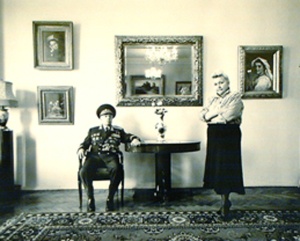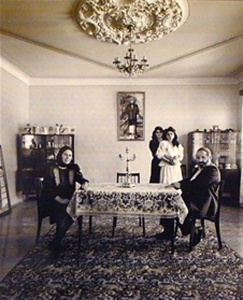Director of the Jewish Image: Frederic Brenner’s Photographs at the Brooklyn Museum

Jews with Hogs (1994) is the first image one encounters in Frederic Brenner’s exhibition of photographs of contemporary Jews from around the world currently at the Brooklyn Museum. In over one hundred and forty black and white photographs the exhibition seeks to document the “multiplicity of Jewish identities.” Throughout the exhibition diversity is the keyword. Diversity…hum.
Jews with Hogs is a large vertical photograph of 20 Florida Jews and their motorcycles (hog is American slang for a large motorcycle) posing in front of a Miami Beach synagogue, its name, Knesset Israel, proudly set over the entrance. The juxtaposition of synagogue and motorcycles sets the complex tone maintained throughout the exhibition. These individuals, each identified by name and profession in the accompanying caption: police officer, liquor store owner, real estate broker, accountant, etc, are in fact a perfectly respectable “gathering” of middle class Jews. The text panel that accompanies the image tells yet another story in which a professor of Judaic Studies, Julius Lester, questions exactly what common ground he might have with these Jewish bikers. He concludes that “they are Jews and I am a Jew but that we are not Jews in the same way…” And so the issue of diversity is explored…or is it? Perhaps the themes of appearance verses reality or confrontation and irony in photographic images are actually scrutinized. Diversity, if relevant at all, is but a starting point that very quickly splinters into complex relationships between image, sign, caption, text and commentary.
In the next room the concept of Diaspora is explored in the text panel Lech Lecha: Go Forth. Diaspora is seen as a universal principle of the Jewish people. Perhaps the historical reality of Diaspora creates a disjunctive Jewish ideal even though it contradicts the Biblical text that commands Abraham to go to a specific homeland. For Brenner the Diaspora with its inherent diversity (that word again) is the paradigm with which to understand the Jewish people. Perhaps.
Frederic Brenner, initially trained as a social anthropologist, has spent the last twenty-four years visiting forty-five countries exploring and documenting Jewish life with his camera. His original impulse was to record simple social phenomena. We see here many beautiful photographs of Jews in Meah Shearim, Ethiopia and in Yemen. Documents. Then in the early 1990’s his methodology shifted radically. As he observed he also began to interact with his subjects. He would do extensive research and conceive of an image he wished to create. He would then carefully craft each scene, posing his subjects to shape and determine a final iconic image after many preparatory shots. He became a director of the Jewish image.
For example, the first image, Jews with Hogs, becomes more understandable when we compare it with other images in the exhibition that are also concerned with a similar theme; Jews and their Judaism. The Jewish Community of Hong Kong Celebrating Purim (1998) are all dressed in black Chinese costume, as they proudly pose in front of, peering out of and perched upon their three story jewel of a synagogue. This image brimming with people explores issues of costume, faith and social reality in the multiracial and devoted Jewish community nestled among seven million Chinese citizens of Hong Kong.
Other Brenner photographs also depict the complex theme of Jews and their Judaism. Jewish Arts Festival in Commack, Long Island panoramically shows seemingly secular Jews photographed in front of a backdrop of the Western Wall dressed up in faux Orthodox garb. Another series of photographs depicts Portuguese Marronos performing for the camera “secret” preparations for Passover in a hidden attic. Perhaps most movingly, two photographs show Lewi Faez taken ten years apart at age 6 and 16 tracing his journey from a hut in Yemen studying with his grandfather to a bare new immigrant apartment in Israel with his young wife and infant child. Lewi tells us in the text panel how difficult the transition is to Israeli society and how he decided after the last photograph to cut off his peyos. For six months his parents didn’t speak to him and “It was hard… [but] I don’t act differently on the outside to what I really am.” The theme of conflict and accommodation is central to modern Jewish life and one that almost all Jews must struggle with at one point in their lives, if not continuously. Brenner’s use of multiple images, textual captions and commentary along with shifts in time and location create a narrative that explores many sides of these fundamental questions. The issue of cultural diversity pales in comparison.

Many diverse themes dominate and shape Brenner’s engagement with essential Jewish issues. Contemporary anti-Semitism is pondered in the brilliant photograph of Billings, Montana, Citizens Protesting Anti-Semitic Acts (1994) while the chilling General David Abramovich Dragunsky, Head of the Anti-Zionist Committee, and His Wife depicts the conundrum of Jewish anti-Semitism. The complicated history of Jews in relationship to Christianity is posed in Souvenir Sellers (1992) that arrays the exclusively Jewish peddlers of miniature saints and Catholic mementos in front of the Vatican. Additionally the deeply disturbing image of an intermarried family in The December Dilemma finds no easy solution to the intolerable demands of two faiths in one house. Jewish Outsiders are explored in a prison Seder, Passover 5754, Maximum Security Women’s Correctional Facility while the heartbreakingly ironic Singles Weekend in the Catskills, Concord Hotel (1994) exposes the pain and longing in the search for a Jewish mate.
One can readily see that these images are artfully constructed under the careful direction of the photographer and therefore are clearly not documents of any existing reality. Rather they are skillful compositions, fascinating tableaus that interact with other photographs in the exhibition to confront the viewer with themes great and small currently challenging the Jewish world. The relationship between image, title and text defines the actual subject of each photograph.

Mourning and loss are paramount within Jewish life cycle events. Commemoration of Mourning for Deceased Son Whose Picture is on the Wall (1990) encapsulates the tragic loss of a son in the context of an Orthodox Russian family. Mother and father are inexplicably separated by the loss while the sisters standing behind them are drawn together. The departed surveys the scene from the back of the dinning room. We can understand their mourning and loss as they console each other. It is domestic. In a stark contrast the series on Argentinean mothers of
![Mothers of “Disappeared” (2000) Buenos Aires [Gallery View] Fiberbase gelatin silver prints (39 x 32) by Frederic Brenner Mothers of “Disappeared” (2000) Buenos Aires [Gallery View] Fiberbase gelatin silver prints (39 x 32) by Frederic Brenner](https://richardmcbee.com/wp-content/uploads/2004/10/argentine_mothers-300x177.jpg)
Frederic Brenner’s work is easily the most exciting and intellectually stimulating photographs around today. Coinciding with the exhibition is the publication of the two-volume Diaspora: Homelands in Exile, published by Harper Collins. The book juxtaposes his photograph with provocative essays by Andre Aciman, Jacques Derrida, Carlos Fuentes, Barbara Kirshenblatt-Gimblett, Julius Lester, Georges Steiner, and Avivah Gottlieb Zornberg. His confrontational images are calculated to initially elicit shock and puzzlement. But once he has our attention, the subtle complexity of the images encourages a prolonged engagement with the meaningful content of each photograph. He asks us no more than to simply pay attention and care about the conflicts and struggles of our fellow Jews. There is a genuine diversity of content in that enterprise.
The Jewish Journey: Frederic Brenner’s Photographic Odyssey
Brooklyn Museum of Art
200 Eastern Parkway, Brooklyn, NY